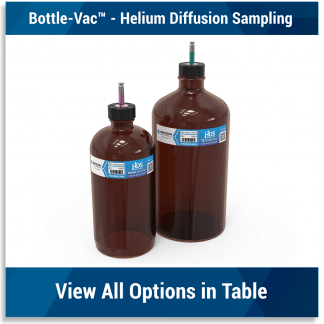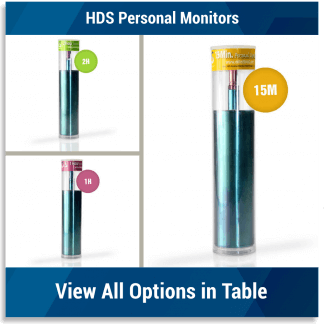Exposure Levels set by OSHA and NIOSH
Canisters have been effective as personal monitors in the workplace for detecting potentially hundreds of chemicals at and below Permissible Exposure Levels set by OSHA and NIOSH.
Canisters have been effective as personal monitors in the workplace for detecting potentially hundreds of chemicals at and below Permissible Exposure Levels set by OSHA and NIOSH.
SiloniteTM MiniCans are used to collect air in the workplace for both Area and Personal Monitoring. Using OSHA Method PV2120, an Entech MiniCanTM is worn on a sampling belt along with a flow controller to perform both 15 minutes Short-Term Exposure Limit (STEL) monitoring, and 1-10 hour Time Weighted Average (TWA) monitoring to obtain an average exposure over an entire work day. Alternatively, the technique called Helium Diffusion Sampling can reduce the size of canister and eliminate the flow controller by using the diffusion of helium out of the canister to control the sampling rate.
The sensitivity of these devices depends solely on how much of the collected sample is injected into the GCMS analyzer, making canister sampling an ideal choice for dealing with wide concentration differences in Real World Samples, as well as the large variations in Permissible Exposure Limits set forth by both OSHA and NIOSH on a compound by compound basis.
Canisters and Bottle-VacTM samplers provide an exciting new way to collect whole air samples in the workplace to determine exposure levels. Whole air sampling does not attempt to “extract” chemicals at the time of sampling and is therefore inherently more reproducible and defensible than the badge, cartridge, and tube sampling. Whether performing Ceiling, STEL, or Time Weighted Average sampling, detection limits are always the same because the total amount of sample collected in each case is the same. Interaction of the target compounds with the matrix is substantially reduced by leaving the sample analytes in the gas phase thus virtually eliminating any matrix effects on target compound measurements.
Ceiling measurements have historically been a challenge because there is no way to quickly and reproducibly collect a sample using tube and badge samplers. MiniCansTM and Bottle-VacTM samplers make this easy. Simply opening and closing the evacuated container accomplishes the task in just a few seconds with extremely high precision. These whole air samplers can easily be checked prior to filling to show that they are still under vacuum; assuring a defensible sample collection process. Detection limits are equal whether performing STEL or TWA sampling procedures, because the sampling container is always filled with the same amount of sample. Even a small 50cc MiniCanTM or Personal Monitor using vacuum to collect the sample will achieve the same detection limits as the larger sampling MiniCansTM and Bottle-VacsTM because just 0.25cc is typically used during each analysis to achieve a 0.05 PPM detection limit for most compounds by GC/FID or GCMS.
Short Term Exposure Limit or STEL monitoring can be performed using either evacuated Bottle-VacTM samplers and MiniCansTM or using the new HDSTM Personal Monitors. Vacuum sampling for 15 minutes into a Bottle-VacTM or MiniCanTM is easily accomplished using a simple restrictor and transfer line leading to the evacuated sampler worn on a convenient waist-mounted pouch. The chart below shows the fill times based on the size of the sampler used. Note that filling with a critical orifice sampler maintains a constant flow rate only until the canister or Bottle-VacTM is half full, then the flow rate will begin to decrease. Fortunately, the sampling can be stopped at 50% of atmospheric pressure while still providing several times the amount of sample needed by a laboratory to perform the analysis. Typically laboratories will measure the pressure, dilute the sample 2–3x to create a positive pressure in the container, and then adjust for the dilution when determining concentrations. Using this approach, the dilution amount is very reliably determined via pressure measurement, allowing a high degree of accuracy.
The IH1200 Personal Monitors utilize classical vacuum sampling into MiniCansTM and Bottle-VacsTM to perform STEL or TWA monitoring for up to 12 hours. Like HDS Personal Monitors, sampling using the IH1200 eliminates the concentration and matrix effects associated with adsorbent-based sampling techniques. The IH1200 is universal, recovering all analytes in a single sampling event with no need to choose different media. Large flow rate adjustments are made by changing inlet restriction, while fine adjustments (2–3x) are made using a built-in flow adjust feature. Enough sample is collected to allow multiple analyses in the laboratory, with detection limits down to low PPB if needed. The IH1200 meets the requirements of OSHA Method PV2120 for determination of workplace contaminants using MiniCanTM samplers. The sampling procedure is easy: Connect an evacuated MC450QT MiniCanTM or 500mL Bottle-VacTM and sampling starts. Monitor the fill rate on the built-in gauge to document a constant fill rate during the sampling event; disconnect the canister to stop sampling.
HDSTM Personal Monitors are a breakthrough technology based on helium diffusion that bring universal and defensible whole air canister monitoring into the realm of personal industrial hygiene monitoring. HDSTM Personal Monitors simplify the collection of chemicals in the workplace and deliver highly reliable results unaffected by factors that create errors in other diffusive samplers – such as matrix concentrations, varying humidity’s, and fluctuating face velocities. An HDSTM sample is easily collected based upon the reproducible diffusion of helium, slowly creating a vacuum that pulls air in actively as helium escapes. A surrogate recovery compound is added to prove recovery during laboratory analysis.




